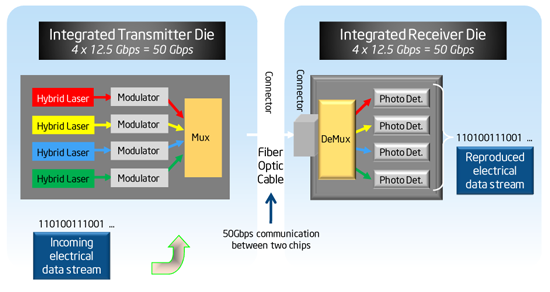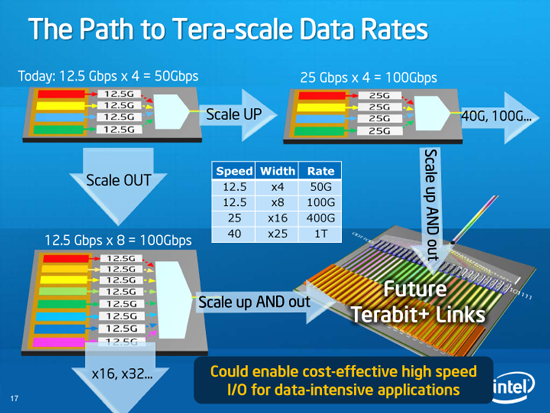Intel's 50Gbps Silicon Photonics Link: The Future of Interfaces
by Brian Klug on July 30, 2010 6:49 AM EST- Posted in
- Trade Shows
- Intel
- Photonics
- Laser
Scaling up (bitrate) and out (WDM)
Intel demonstrated an effective speed of 12.5 gigabits/s per wavelength. Using wavelength division multiplexing (WDM), one can increase the number of wavelengths (or channels) in the fiber, effectively adding more bandwidth. Intel calls this 'scaling out.' This is what’s done in virtually every long haul fiber optic telecommunications network. Even though each wavelength in conventional teleco systems might only be 10 or 20 gigabits/s, the fiber itself can carry many wavelengths, resulting in much higher aggregate bandwidth for a single fiber.

Wavelength Division Multiplexing (WDM)
One can also increase the bitrate of each channel, intel calls this 'scaling up.'

Intel’s demonstration is effectively a vastly miniaturized end to end fiber optic telecommunications system. Instead of cities, you’ve got CPUs and ICHs. Instead of a rack of modulators and optical multiplexers, you’ve got one chip on both ends. The links between components are inevitably going optical, the same way growing need for more and more bandwidth drove almost all terrestrial communications into fiber optic networks.
Both this 50G silicon photonics link and Light Peak are at the core of Intel’s overall I/O strategy for the future, one where copper data links are supplanted almost entirely by optical fibers. No doubt copper will still live on - one still needs to bring power to devices - but in a reduced capacity.
Light Peak is what Intel is calling its first consumer implementation of an external optical bus, and will start at 10 gigabits per second, and will start appearing in products sometime in 2010. The bus will support multiple protocols as well - in theory, you could send USB, ethernet, audio, and video at super fast rates over one unified optical connection. If you think about the same thing happening but on the motherboard, you’ll get a sense for the beginning of how optical data connections will supplant copper.
Hopefully some day we’ll be talking about replacing electrons in microprocessors with photons, and computing entirely with light. Optical computing poses a host of challenges before it can be fully realized, but eventually Intel might replace ICs with photonic equivalents entirely. That future is still decades away, but until then we’ll definitely be using optical busses for moving data around.










42 Comments
View All Comments
DanNeely - Friday, July 30, 2010 - link
I guess, it'd be nice to have this comment maybe include a citation to what other companies are already doing or planning on doing.Huron80 - Friday, July 30, 2010 - link
Look at Infinera, aren't they a networking provider?As stated in the article, Intel is taking what is being done effectively in Fiber Optic network transmissions - the same ones that help connect the internet - and are making a miniature version that will work inside your computer - the connections on the motherboard to components.
has407 - Friday, July 30, 2010 - link
Infinera's achievements are nothing to sneeze at, but they're quite different. AFAIK Infinera still uses a separate process for the optical components (the PIC, or "photonics IC"); they don't put everything on a single die. That's fine for certain markets, and they seem to have done well with Telecoms. However, for large scale low cost production; you're very unlikely to see it replace inter-chip or intra-chip interconnects in volume markets.Luxera is probably closer to what Intel is showing. They partnered with Freescale to integrate the photonics and electronics fab in CMOS last year to allow "low cost high volume" production"; exactly what may come from that is TBD. While we haven't seen much, Luxera's Blazar "Optical Active Cable" is a clue. But again, that's targeted at external inter-system connections; hard to tell if that's due to technology imitations or if Luxera is simply trying to generate revenue and build a market based on the technology is unclear.
In short, it's all about being able to produce everything--optical and electronic components--using a common and low cost fab. In that, Luxera/Freescale and Intel seem to be in the lead, and I'd wager Intel is most likely to bring it mainstream sooner rather than later.
This has the potential to significantly reduce the "interconnect tax" imposed by copper, which increases as speeds increase, and will soon be untenable. Intel said 20GHz was the ceiling for serial interconnects some years ago. (Teething problems related to power consumption with 10Gbe copper provide clues.) Even Inte's prediction is off by a factor of two, the end of that road is in sight.
At a guess, we'll see photonics integration in high-margin parts with the first replacing QPI as the backbone interconnect in high-end systems. Or maybe blade systems with optical backplanes. Or...
Jaybus - Friday, July 30, 2010 - link
Another thing to consider is that one reason for motherboards being as large as they are is that there must be hundreds of traces interconnecting components. Components have to be spread out to leave room for the traces. This technology will allow for one optical link to replace all of the myriad traces connecting the CPU to the northbridge, for example. Components can be closer together.Another factor is bus cards. Cards can be placed anywhere and connected by a single small fiber optic cable. Disk drives, etc. can be connected optically. This will substantially reduce the size of a full featured motherboard.
arnavvdesai - Friday, July 30, 2010 - link
While I agree components can be closer. We also have to think about the issue of heat dissipation. If we start moving items closer then we might have to deal with other issues.Jaybus - Monday, August 2, 2010 - link
Certainly, cooling will force a minimum size, but there is no reason an ATX board could not be shrunk to ITX size, at least, yet have even more i/o capability than a current ATX board. The board components could be placed as closely as is feasible, given the heat dissipation required.clarkn0va - Tuesday, August 3, 2010 - link
Doesn't replacing electrons with photons reduce the amount of heat produced?GullLars - Wednesday, August 4, 2010 - link
Not necessarily, you still need energy converting the digital electronic signal to optical and back, it's just the transport that saves energy, and only as much as the resistance in the copper wire. For high frequency or long distance information transport, it can be noticeable power savings.Regarding cooling, one quick solution is to switch the default from air cooling to liquid cooling in higher power systems. By placing the radiator, pump, and reservoir outside the system, and exploiting the new available dimension inside the case, you can make much smaller (and quieter while better cooled) systems.
Ninhalem - Friday, July 30, 2010 - link
The problem with a shrinking motherboard is that would leave too little room to put in cooling for the CPU and the memory. We're still a ways away from having CPUs running on light like the article said. I'm interested in not only shrinking the board a bit but having a different shape and orientation for the memory, video, audio card, and any other component you have in the case.Maybe have an upside down L shaped board where you can place the SATA II ports close to the hard drives and the optical drive. Maybe a start shaped board. Now that distance doesn't matter, the possibilities are endless. Very fascinating and exciting stuff.
darckhart - Friday, July 30, 2010 - link
sure, but they haven't talked about heat constraints yet.